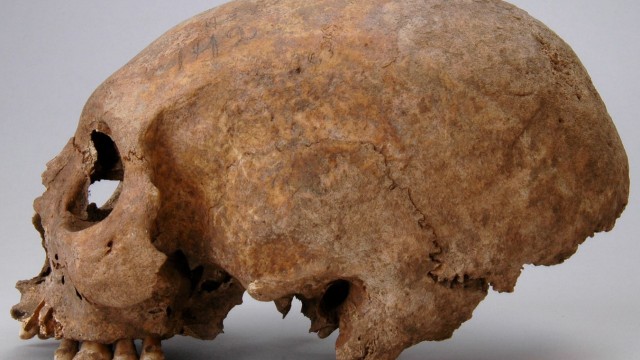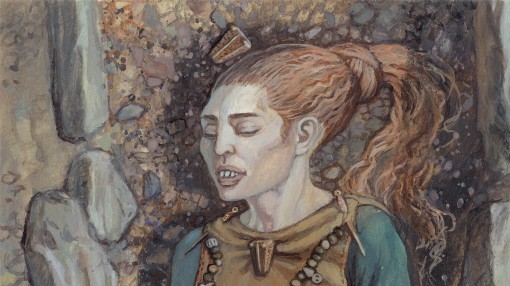The grave actually didn’t differ much from the others. In Havor on Gotland about a millennium ago, people buried a 55 to 60 year old woman. The dead woman lay on her back, less than a meter deep under a flat but extensive hill. She wore everyday clothing and jewelry; in the grave lay beads, rings, two knives and four brooches decorated with animal heads. When archaeologists opened the grave, little of the woman’s skeleton remained. But what kind of strange skull was that?
The woman’s head was stretched unnaturally. Apparently bandages had been tied around her head as an infant to force her still flexible skull into this shape. Such customs have been handed down from South America, Central Asia and Southeastern Europe, as well as from Central Europe during the time of the so-called migration of peoples in the fifth and sixth centuries AD. Dozens of such “tower skulls” were also found in Bavaria. But the fact that this tradition also existed in Scandinavia, and even in the eleventh century, at the end of the Viking Age – that is new.
In recent years, research has increasingly focused on how some Scandinavians of the time deliberately changed their bodies. So far it’s mainly been about teeth: Since 1989, around 130 skulls from the Viking Age have been identified in whose incisors someone had carved horizontal notches. If the gender could be determined, the skulls all belonged to men. But what the notches were used for is unclear. It is sometimes said that the Vikings used them to mark slaves. The lines are often also used as identification interpreted as an identity as a warrior: Dyed with soot, they would have looked frightening, and people would also have demonstrated their own insensitivity to pain.
In the Viking epic “The Northman” (2022), for example, a Valkyrie, a warrior spirit being, is depicted with such colored notches.
The idea that men with notched teeth were warriors fits the Viking stereotype
The archaeologists Lukas Kerk from the University of Münster and Matthias S. Toplak from the Haithabu Viking Museum have now compiled all previously known examples of body modifications using the example of the island of Gotland and tried to interpret them. Like her in the specialist journal Current Swedish Archaeology argue, previous interpretations based on the archaeological finds are rather questionable.
There are statistically no differences in the grave goods between dead people with and without indentations in their teeth, they write. This speaks against the fact that slaves were marked as well as against the idea of a warrior identity. The idea fits with the Viking image of primitive and rough thugs that is widespread in pop culture. But if they were warriors, it would have been expected that the skeletons would have had more battle injuries than others, and that they would have been given weapons to the grave more often than dead people without notches. But neither is the case. Archaeologically there is nothing to suggest a religious background either, as dead people with notches can be found in pre-Christian as well as Christian graves.
Some indentations almost look like predetermined breaking points – like here in the teeth of a skull from the Slite cemetery on Gotland.
(Photo: SHM/Lisa Hartzell SHM 2007-06-13 (CC BY 2.5 SE))
Kerk and Toplak can only speculate as to why the Gotlanders carved notches into their teeth. But the fact that the notches were only found on the teeth of adults suggests a kind of initiation rite, they argue. The markings were also easy to hide behind lips and beard. The majority of the skulls with notches were found at trading places of the time; 46 of them came from the Kopparsvik burial ground alone. There, men with filed teeth were buried in a separate area where there were hardly any graves for women and children. Overall, the two archaeologists believe that the notches could have been a sign of belonging to a group of traders.
Strictly speaking, tooth notches were not counterfeit-proof: anyone who wanted to gain the alleged advantages could carve lines into their own teeth. But examinations of the notches showed that they were filed by a few competent people who knew what they were doing, explains Matthias S. Toplak. The technology is not trivial. He had spoken to many dentists – to their horror – about the tooth notches and believed that laypeople could not easily imitate these filings without causing serious damage to the teeth. They had experimented with teeth and a steel file themselves, so he knew that you really had to apply pressure, says Toplak. In addition, it was an easy-to-hide feature that was not necessarily noticeable to outsiders.
Perhaps the Vikings simply didn’t care about artificially deformed skulls
Tattoos, for example, would have been more noticeable and therefore more suitable for demonstrating clear group affiliation. But even though Viking patterns are popular tattoo motifs today, it is unlikely that the Vikings tattooed themselves, says Toplak. No Scandinavian ice mummies with tattooed skin have been found so far. The only evidence in favor of tattoos is a report from the early tenth century AD by the diplomat Ahmad Ibn Fadlān about a trip to the Varangians in Eastern Europe. According to the Arab, their bodies are covered from head to toe with dark green patterns. But it is uncertain which group Ibn Fadlān described exactly. And it’s unclear whether he really meant tattoos or just body paint, says Toplak. He himself is rather skeptical.

The woman from Havor with the “tower skull” came from Gotland.
(Photo: SHM/Johnny Karlsson 2008-11-05 (CC BY 2.5 SE))
Kerk and Toplak also have to leave open the question of why the woman from Havor’s skull was deformed. According to them, it is even unclear whether anything can be derived from this about the culture of the Scandinavians in the Viking Age. The woman is not an isolated case – a total of three “tower skulls” have been discovered in Scandinavia from that time, all women, all from a similar time, and all on Gotland. But there are no earlier or later finds from the island, and no correspondingly deformed children’s skulls have been found so far. The custom therefore seems to have come to Gotland from outside and not to have caught on there.
Toplak and Kerk locate the origin of the practice in Central Asia or Southeastern Europe. They write that “tower skulls” were still widespread in the eleventh century, especially in the region of today’s Bulgaria. There the deformation was presumably an expression of prestige, and there was evidence of trade contacts between the Gotlanders in these regions. However, it is unclear whether the women were immigrants from there, whether the heads had been deformed there or whether a custom of their trading partners had been imitated. It is also unclear what the other Gotlanders thought of the deformation. In any case, according to genetic analysis, the woman from Havor came from Gotland. One of the others came from the eastern Baltics. And there are no signs in the graves that they were treated worse than others.

